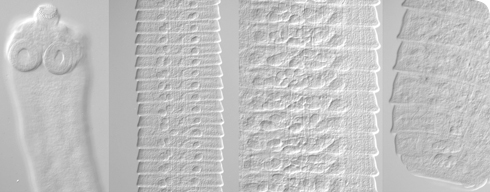Taxonomy
Synonyms
- Vampirolepis microstoma [Dujardin 1854] Spasskii 1954
- Rodentolepis microstoma [Dujardin 1854] Spasskii 1954
- Taenia microstoma Dujardin 1845; Taenia brachydera Diesing 1854; T. murisdecumani Diesing 1863
Evolution
The parasitic flatworms, which includes tapeworms, flukes and ‘monogeneans’, evolved from a single major lineage of free-living flatworm ancestors. The switch from a free-living to a parasitic lifestyle in the common ancestor of the parasitic flatworms involved a fundamental change in their tegument (i.e. ‘skin’), which is found in all contemporary groups.
Early branching tapeworm groups are found in bony (e.g. teleost) and cartilaginous fishes (e.g. sharks and rays) and have entirely aquatic life cycles involving arthropod (e.g. copepods) first intermediate hosts and vertebrate (fish) ‘final’ hosts.
Tetrapod hosts (e.g. mice, humans) were acquired later in tapeworm evolution and eventually part-aquatic life cycles led to the evolution of fully terrestrial life cycles, albeit still involving an arthropod (e.g.beetle) intermediate host and a vertebrate (e.g. mammal, bird) definitive host.
Hymenolepis microstoma is a member of the Cyclophyllidea, one of the youngest and most species-rich group of tapeworms.
